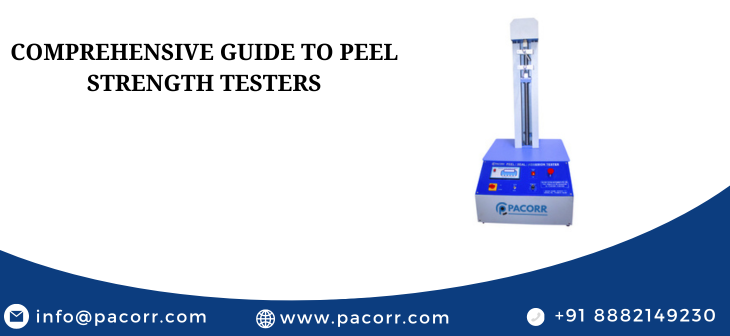
Ensuring the durability and reliability of these adhesive interfaces is crucial, and that's where peel strength testers come into play. In this comprehensive guide, we'll delve into the specifics of peel testers, focusing on the types, applications, and the rigorous standards set by ASTM and ISO. Additionally, we'll spotlight Pacorr, a leading provider of testing instruments, and how their solutions help businesses ensure product excellence.
Peel strength testers are specialized instruments designed to evaluate the adhesive strength of a bond between two materials. These testers can be pivotal in R&D, quality control, and production line testing, ensuring that products meet both consumer expectations and regulatory standards.\
What is a Peel Strength Tester?
A peel strength tester measures the force required to peel an adhesive tape or a bonded material from a substrate. The measurement is typically expressed in Newtons per millimeter (N/mm) and provides a quantitative assessment of the bond strength. This device helps manufacturers understand how well a product will perform under stress or over time, which is essential for maintaining quality and safety standards.
Types of Peel Tests
- 90 Degree Peel Test: This test involves peeling a flexible adherend from a rigid substrate at a 90-degree angle. It is commonly used to assess the bond strength of labels and tapes on a vertical surface.
- 180 Degree Peel Test: In this test, the flexible adherend is peeled back at a 180-degree angle from the substrate, which is typically used for more flexible materials like skin adhesives in medical applications.
These tests not only determine the peak force required to initiate peeling but also the average force needed to continue peeling across a specified length.
Standards Governing Peel Strength Tests
To ensure consistency and reliability in testing, several standards have been developed:
- ASTM D1876: This is a widely recognized standard for performing T-peel tests on adhesives. It specifies the method to measure the relative peel resistance of adhesive bonds between flexible substrates when tested at a 180-degree angle.
- ASTM D6862: It covers the 90-degree peel test, especially useful for pressure-sensitive adhesives.
- ISO 8510-1: This standard details the procedure for determining the peel resistance of adhesive bonds between a rigid substrate and a flexible adherend, typically at a 90-degree angle.
- ISO 11339: Governs the testing of tensile peel adhesion properties for tapes and adhesives used on flexible substrates.
These standards are essential for ensuring that tests are conducted in a uniform manner across different labs and industries.
Pacorr's Peel Strength Testers
Pacorr stands out as a leader in the provision of precise testing instruments, including peel strength testers that comply with international standards. With equipment designed to offer accuracy, repeatability, and durability, Pacorr ensures that industries can maintain the highest quality standards in their products. Their testers are equipped with features that allow for easy setup and operation, making them a preferred choice for both experienced technicians and those new to adhesive testing.
Practical Applications of Peel Testers in Various Industries
- Packaging: Ensuring that adhesives used in packaging have the right strength to withstand transportation and storage conditions.
- Electronics: Testing the adhesion of flexible circuits and touchscreens to their substrates.
- Medical Devices: Ensuring that medical tapes and adhesives used for bandages or transdermal drug delivery systems do not fail during use.
In conclusion, peel strength testers are indispensable in verifying the quality and longevity of adhesive products. By adhering to standards like ASTM D1876 and ISO 11339, manufacturers can ensure their products are reliable and safe for end-users. Pacorr’s contributions to this field with their advanced testing solutions underscore their commitment to excellence in quality assurance.
By leveraging the right peel strength testers and adhering to established testing standards, manufacturers can significantly enhance the reliability and safety of their adhesive products, leading to greater customer satisfaction and compliance with international quality standards

